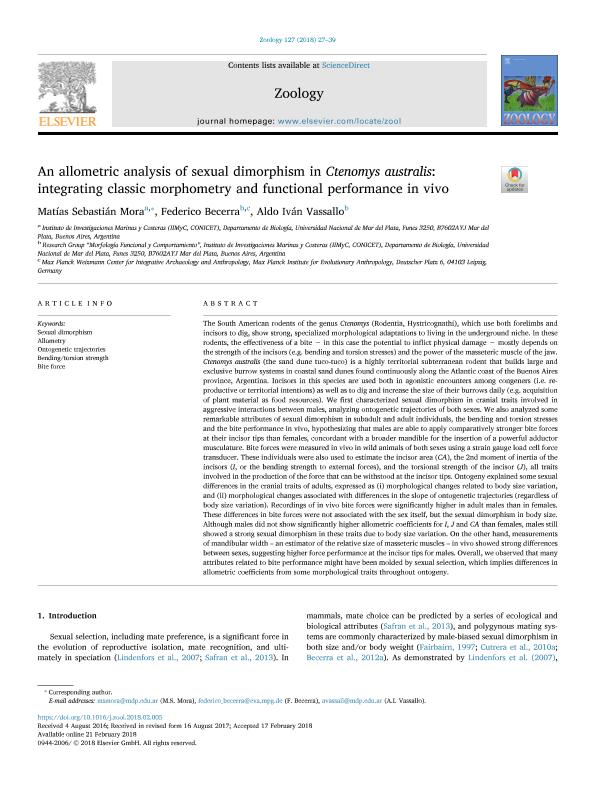Mostrar el registro sencillo del ítem
dc.contributor.author
Mora, Matias Sebastian

dc.contributor.author
Becerra, Federico

dc.contributor.author
Vassallo, Aldo Iván

dc.date.available
2019-10-30T20:03:09Z
dc.date.issued
2018-04
dc.identifier.citation
Mora, Matias Sebastian; Becerra, Federico; Vassallo, Aldo Iván; An allometric analysis of sexual dimorphism in Ctenomys australis: integrating classic morphometry and functional performance in vivo; Elsevier Gmbh; Zoology; 127; 4-2018; 27-39
dc.identifier.issn
0944-2006
dc.identifier.uri
http://hdl.handle.net/11336/87705
dc.description.abstract
The South American rodents of the genus Ctenomys (Rodentia, Hystricognathi), which use both forelimbs and incisors to dig, show strong, specialized morphological adaptations to living in the underground niche. In these rodents, the effectiveness of a bite − in this case the potential to inflict physical damage − mostly depends on the strength of the incisors (e.g. bending and torsion stresses) and the power of the masseteric muscle of the jaw. Ctenomys australis (the sand dune tuco-tuco) is a highly territorial subterranean rodent that builds large and exclusive burrow systems in coastal sand dunes found continuously along the Atlantic coast of the Buenos Aires province, Argentina. Incisors in this species are used both in agonistic encounters among congeners (i.e. reproductive or territorial intentions) as well as to dig and increase the size of their burrows daily (e.g. acquisition of plant material as food resources). We first characterized sexual dimorphism in cranial traits involved in aggressive interactions between males, analyzing ontogenetic trajectories of both sexes. We also analyzed some remarkable attributes of sexual dimorphism in subadult and adult individuals, the bending and torsion stresses and the bite performance in vivo, hypothesizing that males are able to apply comparatively stronger bite forces at their incisor tips than females, concordant with a broader mandible for the insertion of a powerful adductor musculature. Bite forces were measured in vivo in wild animals of both sexes using a strain gauge load cell force transducer. These individuals were also used to estimate the incisor area (CA), the 2nd moment of inertia of the incisors (I, or the bending strength to external forces), and the torsional strength of the incisor (J), all traits involved in the production of the force that can be withstood at the incisor tips. Ontogeny explained some sexual differences in the cranial traits of adults, expressed as (i) morphological changes related to body size variation, and (ii) morphological changes associated with differences in the slope of ontogenetic trajectories (regardless of body size variation). Recordings of in vivo bite forces were significantly higher in adult males than in females. These differences in bite forces were not associated with the sex itself, but the sexual dimorphism in body size. Although males did not show significantly higher allometric coefficients for I, J and CA than females, males still showed a strong sexual dimorphism in these traits due to body size variation. On the other hand, measurements of mandibular width – an estimator of the relative size of masseteric muscles – in vivo showed strong differences between sexes, suggesting higher force performance at the incisor tips for males. Overall, we observed that many attributes related to bite performance might have been molded by sexual selection, which implies differences in allometric coefficients from some morphological traits throughout ontogeny.
dc.format
application/pdf
dc.language.iso
eng
dc.publisher
Elsevier Gmbh

dc.rights
info:eu-repo/semantics/openAccess
dc.rights.uri
https://creativecommons.org/licenses/by-nc-sa/2.5/ar/
dc.subject
ALLOMETRY
dc.subject
BENDING/TORSION STRENGTH
dc.subject
BITE FORCE
dc.subject
ONTOGENETIC TRAJECTORIES
dc.subject
SEXUAL DIMORPHISM
dc.subject.classification
Zoología, Ornitología, Entomología, Etología

dc.subject.classification
Ciencias Biológicas

dc.subject.classification
CIENCIAS NATURALES Y EXACTAS

dc.title
An allometric analysis of sexual dimorphism in Ctenomys australis: integrating classic morphometry and functional performance in vivo
dc.type
info:eu-repo/semantics/article
dc.type
info:ar-repo/semantics/artículo
dc.type
info:eu-repo/semantics/publishedVersion
dc.date.updated
2019-10-24T19:07:58Z
dc.identifier.eissn
1873-2720
dc.journal.volume
127
dc.journal.pagination
27-39
dc.journal.pais
Alemania

dc.description.fil
Fil: Mora, Matias Sebastian. Consejo Nacional de Investigaciones Científicas y Técnicas. Centro Científico Tecnológico Conicet - Mar del Plata. Instituto de Investigaciones Marinas y Costeras. Universidad Nacional de Mar del Plata. Facultad de Ciencias Exactas y Naturales. Instituto de Investigaciones Marinas y Costeras; Argentina
dc.description.fil
Fil: Becerra, Federico. Institut Max Planck for Evolutionary Anthropology; Alemania. Consejo Nacional de Investigaciones Científicas y Técnicas. Centro Científico Tecnológico Conicet - Mar del Plata. Instituto de Investigaciones Marinas y Costeras. Universidad Nacional de Mar del Plata. Facultad de Ciencias Exactas y Naturales. Instituto de Investigaciones Marinas y Costeras; Argentina
dc.description.fil
Fil: Vassallo, Aldo Iván. Consejo Nacional de Investigaciones Científicas y Técnicas. Centro Científico Tecnológico Conicet - Mar del Plata. Instituto de Investigaciones Marinas y Costeras. Universidad Nacional de Mar del Plata. Facultad de Ciencias Exactas y Naturales. Instituto de Investigaciones Marinas y Costeras; Argentina
dc.journal.title
Zoology

dc.relation.alternativeid
info:eu-repo/semantics/altIdentifier/doi/http://dx.doi.org/10.1016/j.zool.2018.02.005
dc.relation.alternativeid
info:eu-repo/semantics/altIdentifier/url/https://www.sciencedirect.com/science/article/pii/S0944200618300308#!
Archivos asociados
